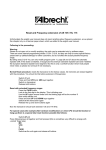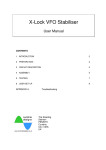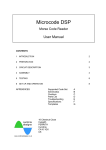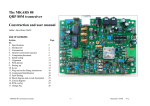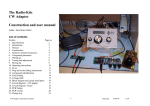Download X-Lock 3 - Cumbria Designs
Transcript
X-Lock VFO Stabiliser User Manual CONTENTS 1 INTRODUCTION 2 2 PREPARATION 2 3 CIRCUIT DESCRIPTION 3 4 ASSEMBLY 5 5 TESTING 7 6 CONFIGURATION AND SET UP 8 APPENDIX A Troubleshooting 16 Chestnut Close Culgaith PENRITH Cumbria CA10 1QX UK 1 Introduction Thank you for purchasing the Cumbria Designs X-Lock kit. We hope that you enjoy constructing this kit and find many uses for this feature rich design. This manual describes the assembly and operation of the X-Lock kit, even if you are a seasoned constructor, we respectfully ask that you read this manual and familiarise yourself with the instructions and kit contents before commencing construction. If assembled carefully, this unit will provide many years of reliable service. The Cumbria Designs Team ________________________________________________________________ 2 Preparation 2.1 Tools We recommend that the following tools are used during assembly and testing; 25W fine tipped soldering 60/40 Rosin cored solder 5” or smaller diagonal side cutters 2.4 Small pointed nosed pliers Solder sucker (just in case!) Multimeter 2.2 Conventions The following symbols are used within the assembly instructions to draw attention to critical steps such as component orientation and anti-static precautions. The associated narrative describes the action required. ! Critical Step Static Sensitive Don’t be tempted to rush the construction, even though this is a relatively simple kit, a wrongly placed component can provide hours of frustrating fault finding. Also, as this kit uses a double sided Printed Circuit Board (PCB) with through plating, removal of a wrongly soldered part can be difficult. Follow the assembly instructions carefully to avoid mistakes. All parts carry a coded identity to describe their values. It is important to be able to recognise these during assembly. Capacitors have their value printed numerically, e.g. 104 = 100nF, 103 = 10nF etc. Resistors have their values represented by coloured bands – this is a frequent source of confusion! To simplify component identification, the parts list carries the identities of each component as it appears on the device. For resistors the colour coding is given. This should be referred to during assembly to ensure the right parts are placed in their respective positions on the PCB. 2.5 2.3 Assembly The production of a successful finished working kit is dependent upon careful component handling, careful placement and good soldering! X-Lock 3 PCB 3.0 Component Identification Component Leads Many of the passive components will require their leads to be formed to align with the holes on the PCB. This mainly applies to the axial parts such as resistors and diodes. Forming Doc Rev1.2 © Cumbria Designs Page 2 of 14 component leads is easily done with a pair of pointed nose pliers and using the hole spacing on the PCB as a measure. Alternatively, small formers made from scrap off cuts of Vero board etc make ideal templates that produce consistent results. Some parts, such as variable resistors, have preformed leads designed for machine assembly. These will require straightening to align with the board layout. Again, a pair of pointed nose pliers should be used to carefully flatten the factory performing to produce straight leads. 2.6 Soldering Before applying solder check carefully that the component you have placed is in the right position! This is a through plated double sided board. Whilst some of the pads are very small, the area presented by the through plating is more than adequate to allow good solder flow to form mechanically strong good electrical joints. These can be difficult to undo, please double check! • This is the bit that can trip up even experienced constructors. For the solder to fuse with the surfaces to be joined it is necessary for them to be hot – but not so hot as to damage the parts! It’s a simple as 1-2-3; 1. Place the tip of the iron against the joint, hold it there briefly to bring the metal surfaces up to temperature. 2. Apply the solder allowing it to flow smoothly onto the surfaces. 3. Remove the iron and inspect the new joint. The finished joint should have a smooth shiny coating of solder. If the joint is dull grey or has formed a spherical “blob”, apply the iron to the joint, remove the old solder with a solder sucker and re-solder. 3 Circuit Description 3.1 The majority of problems are likely to be caused by soldering faults. These can sometimes be difficult to find. Here are some basic golden rules that will help you to avoid poor solder joints; • Clean Iron Make sure your soldering iron tip is in good condition and tinned. A small moistened pad for cleaning tips, regularly used to wipe off excess solder and flux, will ensure that your iron performs well. Remember to tin the iron immediately after each wipe. • Clean Leads and Pads All of the component leads and PCB pads in this kit are pre-tinned and should not need cleaning before soldering. Please ensure that parts are handled so as to avoid contamination with grease or fingerprints. X-Lock 3 PCB 3.0 Soldering General The X-Lock is a micro-controller based frequency stabiliser designed as an easily applied “add-on” to enhance the frequency stability of existing free running variable frequency oscillators (VFOs). This compact module will accept an input signal with a range of a few tens of kHz to over 50MHz and produce a variable correction voltage to drive a simple drift compensation circuit fitted to the host oscillator. To minimise the risk of introducing digital noise to the host oscillator, the analogue section of the X-Lock operates from its own regulated supply and is optically coupled to the digital control circuitry. Two tactile switches allow the key parameters to be adjusted after installation. A tri-colour LED indicates operational and diagnostic status. Doc Rev1.2 © Cumbria Designs Page 3 of 14 3.2 Theory of Operation The Cumbria Designs X-Lock is a derivative of the “Huff-Puff” stabiliser system devised by the late Klaas Spaargaren PA0KSB in the 1970’s. The x-Lock compares the frequency of the controlled oscillator with a crystal reference (hence X-Lock = Xtal-lock), to produce a correction signal which is used adjust the frequency of the oscillator. The action is to hold the frequency of the controlled oscillator frequency at 10Hz lock points. At the heart of the X-Lock is a 16F628 processor (IC3) which performs all of the measurement and control operations. The input signal is buffered by Q1 and amplified by Q2 before being presented to the input of the processor on pin 12. The gate circuit is internal to the processor and operates over a 100mSec period to provide a count resolution of 10Hz. The value of each measurement is compared with that of the previous and if the difference is equal to or less than 50Hz, the 16F628 processor will generate a correction signal. This takes the form of variable duration control pulses on the Up and Down signal lines from the processor to drive LED’s within the opto-coupler, IC4. The opto-coupler transistors are operated by the LEDs to charge or discharge the voltage stored in the loop filter R9, C11 and C15. The time constant of the loop filter is very long resulting in a slow rate of change of the control voltage. To ensure that the control voltage starts at centre rail, a reset switch formed by FET Q3 is enabled by the processor on power on. This ensures that C11 and C15 are fully discharged. Once Q3 is turned off, the capacitors re-charge via R5 to set a centre rail output voltage. In the unlikely event that the loop control voltage becomes “saturated” after a prolonged period of operation, the X-Lock 3 PCB 3.0 control voltage can be set to centre again by briefly powering the X-Lock on and off to operate the Q3 reset switch. The host VFO will need to be retuned following a reset. A rail to rail operational amplifier IC5, buffers the filter, providing a low impedance source for the control voltage to drive the external compensation varactor. Whilst the varactor circuit exhibits a very high input impedance at DC, the low impedance of the operational amplifier output stage reduces the effects of stray voltages on the control voltage line. A simple RC filter (R10 and C16), decouples the control signal at the point where it leaves the X-Lock PCB. There are two voltage regulators on the X-Lock PCB. IC2 provides the +5V supply for the 16F628 and the input amplifier, IC1 provides +8V supply for the loop filter and output amplifier. The use of separate regulated supplies provides good isolation between the digital and analogue stages and offers a wide operating range for the control voltage reducing the possibility of loop saturation. A 1N4004 power diode, 100K resistor, 22pF and 68pF capacitors are included with the X-Lock kit. These are intended to be configured as a varactor correction circuit shown in fig.1. This circuit should be suitable for most applications up to about 15MHz. Above this frequency the value of the coupling capacitor may need to be reduced considerably to prevent over correction. An alternative to using an additional correction circuit is to merge the correction signal with an existing RIT line. More information on this together with specific examples are available on the Cumbria Designs website; www.cumbriadesigns.co.uk Doc Rev1.2 © Cumbria Designs Page 4 of 14 4 Assembly The following assembly sequence is recommended. This allows most of the smaller parts to be held in place with the board turned over whilst soldering the underside. All components are mounted on the top (silk screen) side of the board. 4.1 Fixed Resistors (Broad tolerance band shown in capitals) 100R 390R 470R 1K 10K 100K 390K 2M2 4.2 ! R2, R4 R5, R10, R11, R13 R1, R6, R14 R3 R8 R9 R7 R12 Brown, Black, Black, (BROWN) Orange, White, Black, Black, (BROWN) Yellow, Mauve, Black, Black, (BROWN) Brown, Black, Brown, (BROWN) Brown , Black ,Black, Red, (BROWN) Brown, Black, Black, Orange, (BROWN) Orange, White, Black, Orange, (BROWN) Red, Red, Black, Yellow, (BROWN) IC Sockets Ensure correct orientation! Match index cut out on socket to board printing. Tip; solder one pin only then check positioning before continuing. Heat solder and reposition if necessary. a) b) 4.3 Fit the 18 pin microcontroller socket for IC3 Fit 8 pin sockets for IC4, IC5 Crystal Fit X1, the 20MHz crystal. This is heat sensitive and is easily damaged if overheated. It is recommended that a gap of about 2mm is left between the crystal and the PCB. This will provide a little extra thermal isolation during soldering. 4.4 Ceramic Capacitors Suggested Installation order; 22pF 10nF 100nF 4.5 ! C5, C6 C2, C8, C9, C12, C13, C15, C16 C7 22J 103 104 Transistors and Diode Polarity conscious components. Ensure correct orientation. The 2N5485 and 2N7000 are Static sensitive parts. Discharge yourself to ground before handling. Avoid wearing static generating clothing (e.g. wool, man made fibres etc) during assembly. a) b) c) Fit JFET Q1 Fit Bipolar transistor Q2 Fit FET Q3 X-Lock 3 PCB 3.0 2N5485 MPSH-10 2N7000 Doc Rev1.2 © Cumbria Designs Page 5 of 14 d) ! 4.6 Install D1 BAV21 Regulators Polarity conscious components. Ensure correct orientation. ! When installing the two T092 Voltage regulators, ensure that their orientation matches that shown on the silk screen. a) b) 4.7 Fit 8V regulator IC1 78L08 Fit 5V regulator IC2 78L05 Tactile Switches Insert and solder the two 7mm tactile switches into positions SW1 and SW2. The pin spacing ensures that the switches can only be fitted in one plane. Press each switch into place gently, once inserted the corrugated pins will hold the switch in place for soldering. 4.8 ! Electrolytic Capacitors Polarised Capacitors, observe the polarity shown by the silk screen. 10uF 100uF 4.9 C1, C3, C4, C11 C10, C14 Connectors Recommended Pin Header Connector orientation is with rear locking tab facing into the centre of the board. A three way header is provided for the LED to allow it to be remotely fited to a front panel if required. a.) b.) Fit the 4 two pin headers PWR, RF, T/R, VAR If you wish to extend the Tri-Colour LED, fit the three way LED header. 4.10 Status LED The Tri-colour LED has three leads. The centre lead is the cathode and the two outer leads are anodes for the red and green LEDs. The shorter of the outer leads is the red LED anode. The Tri-colour LED is connected with the short lead (red anode) nearest the crystal X1. The LED may be mounted directly on the PCB or connected via the supplied three way header if remote viewing is required. 4.11 Semiconductors Static sensitive parts. Discharge yourself to ground before handling. Avoid wearing static generating clothing (e.g. wool, man made fibres etc) during assembly. Orientation is critical. Observe correct alignment of IC pins which will need to be gently formed for correct alignment before insertion into sockets. IC pins can be X-Lock 3 PCB 3.0 Doc Rev1.2 © Cumbria Designs Page 6 of 14 pushed inwards by placing the device on its’ side on a firm surface, and gently pressing the body down against the pins. When inserting parts, take care to check orientation and pin alignment. Fit Fit Fit IC3 IC4 IC5 PIC16F628A ACPL827 (A 827) MC33201 Processor (18 pin DIL) Dual opto-coupler (8 pin DIL) Operational Amplifier (8 pin DIL) 4.12 Connector Assemblies Connector shells and pins are supplied to allow connection of power and signal lines to the X-Lock. The use of good quality, colour coded, heat resistant, multi stranded wire is recommended. To avoid accidents, a colour code convention should be chosen to represent function, e.g. Red +ve supply, Black ground, striped colours controls etc. The connector assemblies comprise of two components; the shell and the pins. To terminate a conductor first strip back about 2mm of insulation and tin the exposed wire. Place the tinned end of the wire into a pin such that the tinned wire sits inside the inner pair of tabs and the insulation sits within the outer tabs. With small pointed nose pliers carefully compress the outer tabs onto the insulation to hold the wire. Repeat this with the inner tabs to grip the exposed conductor. Very carefully solder the exposed conductor in place taking care not to allow solder to flow onto the locking tab. Finally, insert the pin into the shell with the small locking tab orientated to the face of the shell with the small cut outs. Push home until the locking tab snaps into the cut out. Should you need to remove a pin, gently press the locking tab in with a small screwdriver or the end of a pair of pointed nose pliers. The pin will be released and can be pulled out of the shell. Assembly complete, well done! Now carefully check your work for dry joints and bridges before moving on to testing. 5 TESTING Before connecting the X-Lock to your power supply for the first time, carry out these simple checks – just to be safe! 5.1 Basic Electrical Tests 5.1.1 +12 Volt Input With a multimeter set to resistance, place the Red meter lead onto +12v and the Black to Ground and check for a high resistance. Note that due to C11 charging the reading will show change, providing there is not a short circuit then all is well. 5.1.2 +5 and +8 Volt Rails Carry out the resistance test on the output side of the regulators (IC1 and IC2) to check the integrity of the regulated rails. Due to the circuitry of the X-Lock a much lower resistance will be measured, the reading will depend upon the characteristics of the multi-meter but typically should be around 250 Ohms. X-Lock 3 PCB 3.0 Doc Rev1.2 © Cumbria Designs Page 7 of 14 5.2 Powering Up 5.2.1 Power With no controls set, connect a +12 volt supply to the X-Lock. Double check the polarity, take a deep breath and switch on. The status LED will sequence through Red, Amber and Green and then flash Red on and off indicating that there is no signal input. 5.2.2 RF Checks Connect a signal source of around 500mV peak to peak or greater between the RF input pin and ground, the status LED should stop flashing Red. If it doesn’t, check the connection to the oscillator and the signal level. At higher frequencies, more drive may be necessary. If the signal source is stable enough, the LED may illuminate Green indicating that the drift rate between measurements is low. This concludes the unit testing. 6 CONFIGURATION AND SET UP 6.1 Installation Install the X-Lock as close as possible to the VFO that it will work with. Keep all signal leads as short as possible to minimise any unwanted radiation or pick up. The X-Lock requires a smoothed DC supply in the range +10V to +16V, supply voltages greater than +16V should be avoided to prevent over heating of the regulators. 6.2 Connection to a VFO 6.2.1 X-Lock RF Input The RF input should be taken from the output of the buffer stage to avoid loading the VFO. This will typically be a low to medium impedance source which should be capable to developing 500mV peak to peak or greater across the XLock RF input without the loading presented by the X-Lock significantly reducing the signal level. 6.2.2 Correction Circuit The control voltage output (VAR) of the X-Lock is used to drive a varactor in the VFO tuned circuit. A 1N4004 diode, 100K resistor, 10nF and 68pF and 22pF capacitors are included in the kit to form the varactor circuit. Whilst the 68pF or 22pF capacitors should be satisfactory for many applications, it may be necessary to reduce this value significantly, particularly for high VFO frequencies or where the capacitor is connected directly across the VFO tuned circuit. In these instances the frequency control range may be excessive, resulting in poor lock or high levels of ripple. For best results it is recommended that the coupling capacitor value is chosen to give around 20kHz of frequency change for a control voltage range of 0v to +12v. (Test the varactor control range without the X-Lock connected). Alternatively it may be possible to find a connection point in the VFO circuit where either the 22pF or 68pF capacitor will give a satisfactory tuning range. This might be an existing tap on the inductor or across the lower feedback capacitor in the case of a Colpitts oscillator. X-Lock 3 PCB 3.0 Doc Rev1.2 © Cumbria Designs Page 8 of 14 The circuit configuration is shown in Fig.1, all component leads on the VFO side of the 100K resistor should be kept as short as possible to offer best mechanical stability. Be careful to confirm that the voltages at the point of connection in the VFO do not exceed 50v DC. The AC component should be no greater than 5v p-p. Coupling Capacitor (See Text) Control Voltage from X-Lock (VAR) 10nF Ceramic Cathode (Control Voltage) 100K To VFO tuned circuit Varactor Diode (1N4004) Anode (Ground) 1N4004 Fig.1 VFO Connection 6.3 Using the RIT Line for Correction Many X-Lock users have successfully coupled the VAR correction voltage into the transceiver RIT line. Various approaches have been used from simple resistive summing to more complicated Op Amp summing circuits. More information on this together with details of installations made by our customers is available on our website. 6.4 Operation with a VFO With the X-Lock is connected to a VFO the operating parameters may be changed to optimise performance and suit personal preferences. 6.4.1 Initialisation On switch on the X-Lock will run through an initialisation check (indicated by the red/amber/green phase of the tri-colour status LED) and then commence measurement the host VFO frequency. Once the VFO switch on drift has fallen below 50Hz/sec, the X-Lock will apply correction control signified by the status LED changing from red to green. When stabilisation has been achieved the LED will remain green. Depending upon the VFO warm up characteristics, the coupling of the correction circuit and the chosen correction rate, lock may be intermittent during the first minute or two of operation. 6.5 Set Up Mode The operating parameters of the X-Lock can be changed to optimise performance or customise operation with a particular VFO. Set Up mode allows three parameters to be changed; a. Correction rate b. Post Tuning Delay c. RIT Mode 6.5.1 Changing the Correction Rate The rate of change of the control voltage is set by the correction pulse width and the R9, C11 and C15 time constant. The correction rate may be adjusted by changing the basic correction pulse width, there are 8 settings ranging from 10uSec doubling on each step to a maximum of 1.28mSec. The “factory” setting X-Lock 3 PCB 3.0 Doc Rev1.2 © Cumbria Designs Page 9 of 14 is the maximum (1.28mSec). Whilst this will ensure quick and effective locking it may be too “severe” for some VFOs resulting in a noticeable “warble” on received signals. The pulse width is adjusted as follows; a.) With the X-Lock operating and locked (LED green) press SW2. If this is the. first change or the adjustment is at one of the end limits the LED will change to red. If the current setting is somewhere in between, the LED will extinguish. b.) Press SW1 to reduce the pulse width or SW2 to increase the pulse width. Each step change is marked by the LED flashing amber. When either end limit is reached the LED will change to red. c.) By allowing the X-Lock to settle between changes, the effect of the new pulse setting may be monitored. The optimum value will provide good stabilisation with no “warble” caused by correction signal changes. To save the new setting press and release SW1 and SW2 simultaneously. The LED will flash green indicating that the setting has been saved and normal operation will resume. The new setting will be loaded each time the X-Lock is powered on. 6.5.1 Post Tuning Delay During VFO tuning, the X-Lock will halt correction and hold the control voltage at the current value. The status LED will turn red indicating an unlocked state. Once tuning is stopped, the X-Lock will wait for a period set by the Post Tuning Delay (PTD) before re-applying lock. This allows time for slow or fine manual tuning adjustments to be completed without the X-Lock attempting to compensate for what it may see as drift. 6.5.1.1 Changing the Post Tuning Delay The “factory” default PTD is set at 2 seconds, this may be changed to settings of 1 to 15 seconds in 1 second steps. The PTD is changed as follows; a) With the X-Lock powered up press SW1. The status LED will extinguish indicating that set Up Mode has been entered. b) Change the PTD by pressing and holding SW1 to reduce the PTD or SW2 to increase the PTD. The status LED will flash amber once every second change. Once the lower limit of 1 second or the upper limit of 15 seconds is reached, the status LED will flash red). c) To save the new PTD setting, simultaneously press SW1 and SW2. The LED will flash green acknowledging the change. The new delay setting is now active and will be applied on each subsequent power on. 6.5.2 RIT Mode The X-Lock has two Receiver Incremental Tuning (RIT) modes; automatic and external RIT control. 6.5.2.1 Automatic RIT An innovative feature of the X-Lock is its ability to detect and respond to the rapid frequency changes associated with RIT operation in a transceiver. In automatic mode the X-Lock identifies and memorises the two frequencies use for RIT and uses them for locking the VFO after each RIT transition. Under most circumstances automatic mode will be the best RIT option. X-Lock 3 PCB 3.0 Doc Rev1.2 © Cumbria Designs Page 10 of 14 6.5.2.2 External RIT Where it is desired to link the X-Lock into the host transceiver’s RIT control system, and external RIT control input is provided. The signal driving this input must be conditioned as follows; a.) Receive b.) Transmit +3V to +20Vmax 0V to +2V Under no circumstances should the control voltage exceed these limits or fall below -0.7V or damage to the processor may result. 6.5.2.3 Changing RIT Mode The “factory” setting is automatic mode, the RIT mode is changed as flows; a.) With the X-Lock powered off, press and hold down SW1 for Automatic RIT mode or SW2 for External RIT mode. b.) Power on the X-Lock. The green LED will flash to acknowledge the change. Release the button and normal start up will resume. The new setting will be loaded each time the X-Lock is switch on. Appendix A Troubleshooting The following checks may help in identifying the cause of operational problems. Area Symptoms Actions LED LED regularly flashes RED Input level too low or absent, check connection to VFO and drive level. Input OK but VFO drifting greater than 50Hz/second. (Normal during VFO initial warm up). Check varactor circuit installed correctly, check control voltage present at varactor circuit input. Check Power Supply polarity. Check +12V on inputs to Regulators. Check Regulator Ground continuity Check +8V regulator for input and output, confirm correct orientation. Are IC4 and IC5 inserted correctly? Check soldering of IC4 and IC5 pins Check correction circuit shifts VFO frequency by applying DC voltage. Check diode orientation and coupling into VFO. VFO not stable enough. Check design. Increase correction rate. Increase correction varactor coupling into VFO. Reduce correction rate. Decrease correction varactor coupling into VFO. LED permanently RED or LED flickers RED/GREEN. Received signals sound clean. Power Power applied but unit doesn’t work. Little or no current drawn. Poor or No Lock LED goes through initialisation sequence but there is no control voltage output. LED shows initialisation successful but VFO is not stabilised. VFO sounds clean but still drifts. LED Flickers Red/Green. Over Correction X-Lock LED shows lock and VFO is stable but warbling evident on received signals. VFO “jitters” causing warbling modulation on received signals. LED Flickers GREEN/RED. X-Lock 3 PCB 3.0 Varactor is over compensating pulling VFO out of lock range. Reduce correction varactor coupling into VFO. Doc Rev1.2 © Cumbria Designs Page 11 of 14 X-Lock Schematic X-Lock 3 PCB 3.0 Doc Rev1.2 © Cumbria Designs Page 12 of 14 X-Lock Component Overlay The Assembled Kit X-Lock 3 PCB 3.0 Doc Rev1.2 © Cumbria Designs Page 13 of 14 X-LOCK PCB VERSION 3.0 PARTS LIST Resistors 2 100R 4 390R 4 470R 3 1K 3 10K 1 100K 1 390K 1 2M2 R2, R4 R5, R10, R11, R13 R1, R6, R14 R3 R8 R9 R7 R12 Capacitors 2 22pF 7 10nF 1 100nF 4 10uF 2 100uF Ceramic Capacitor Ceramic Capacitor Ceramic Capacitor Electrolytic Capacitor Electrolytic Capacitor Semiconductors Q1 2N5485 Q2 MPSH10 Q3 2N7000 IC1 78L08 IC2 78L05 IC3 PIC16F628A IC4 ACPL827 IC5 MC33201 LED Tri-colour LED D1 BAV21 Crystal X1 C5, C6 C2, C8, C9, C12, C13, C15, C16 C7 C1, C3, C4, C11 C10, C14 JFET NPN transistor FET 8v T092 Regulator 5v T092 Regulator Microcontroller Dual Optocoupler (Marked A 827) Operational Amplifier Diode 20MHz Connectors, IC Sockets and Switches 1 3 Way Pin Header JP1 1 3 way Shell 4 2 Way Pin Header PWR, RF, T/R, VAR 4 2 Way Shells 11 Crimp Pins 1 18 Pin DIL Socket 2 8 Pin DIL Sockets 2 Tactile Switches S1, S2 PCB X-Lock v3.0 External VFO Parts 1 1N4004 Diode 1 100K Resistor 1 22pF Ceramic Capacitor 1 68pF Ceramic Capacitor 1 10nF Ceramic Capacitor END X-Lock 3 PCB 3.0 Doc Rev1.2 © Cumbria Designs Page 14 of 14














